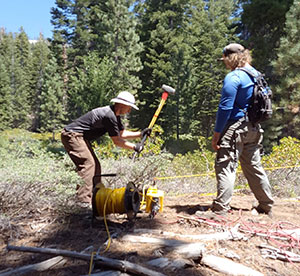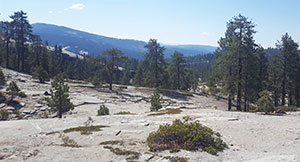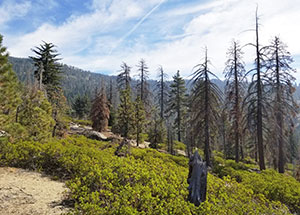Former UW Ph.D. Student Leads Research That Finds Forest Drought Affected by Differences in Underlying Bedrock Composition
Published September 08, 2022

Russell Callahan, a former University of Wyoming Ph.D. student, led research in California that found differences in underlying bedrock composition are a key factor in how tree stands in forests respond to drought after wildfires.
“This work shows previously unrecognized connections between the types of bedrock underlying forests and how well the forests do during droughts,” says Callahan, who was a Ph.D. student in geology at UW from 2015-2021 and a postdoctoral researcher there during 2022. “The finding is a bit counterintuitive, because it shows that areas that can store more water are actually worse off during the drought. This is because the bedrock in these areas supports forests with more vegetation that need greater amounts of water to survive.”
Callahan, who became a postdoctoral researcher in the Earth and Planetary Sciences Department at the University of California-Santa Cruz in July, is corresponding author of a paper titled “Forest Vulnerability to Drought Controlled by Bedrock Composition,” which was published Sept. 6 in Nature Geoscience. The journal covers all aspects of the earth sciences, including theoretical research, modeling and fieldwork.
Cliff Riebe, a professor of geology and geophysics; Nicholas Taylor, a former master’s degree student; and Dario Grana, a professor and Wyoming Excellence Chair in geology and geophysics, were other UW researchers who contributed to the paper.
Additionally, researchers from Concordia University in Montreal, Quebec, Canada; Universite Paris Coite in Paris, France; the University of Wisconsin-Madison; Simon Fraser University in Burnaby, British Columbia; Clemson University; Dickinson College in Carlisle, Pa.; and Virginia Tech University made contributions to the paper.
“This work can help explain why trees in some forests survived during drought and other areas experience large amounts of tree mortality,” Callahan says. “Understanding the variability in drought response is very important across the western United States, as drought causes large amounts of tree mortality.”

More than 140 million trees were killed in California from 2011-17 due to drought, helping fuel some of the most devastating wildfires on record. In the midst of the devastation, some areas of trees have survived, indicating that -- for reasons previously not understood -- some forest stands are more vulnerable than others.
The new paper suggests that the patchiness of drought and wildfire damage to the forests can be explained by differences in underlying bedrock composition.
“Small differences in the minerals and nutrients in the bedrock can lead to large differences in vegetation dynamics,” Callahan explains. “Differences in nutrients influence the amount of vegetation on the surface, and differences in the minerals determine how much space there is for water to be stored in the subsurface.
“Areas with bedrock that have more nutrients and produce greater water storage promote more vegetation growth during nondrought periods,” he continues. “When water is limited, these areas use the stored water more rapidly and experience mortality during droughts. One helpful analogy is that areas with more trees have too many straws in a cup and deplete the water more quickly.”

The research team studied three core study areas in California -- Bald Mountain, Dinkey Dome and Duff Creek. The fieldwork primarily occurred during the summer of 2016, with some additional work in 2018 and 2019, Callahan says.
The group measured bedrock composition; water storage capacity using near-surface geophysics; and forest dieback using satellite imagery. The study expanded the work to 18 additional sites where previous work measured bedrock composition.
“At the 18 additional sites, we were not able to make the geophysical measurements,” Callahan says. “But we did measure dieback with satellite imagery to verify that the patterns at the three core sites were widespread across the broader central Sierra Nevada.”
The findings of this work have important implications for understanding how forests in California will change as droughts become more frequent and more intense.
“Ultimately, this work suggests that the underlying bedrock sets a template for forest drought response,” Callahan says. “These findings could be used to direct resources to areas that may be more vulnerable to dieback due to the underlying bedrock composition.”
The study was funded by grants from the National Science Foundation, NASA and the Natural Sciences and Engineering Research Council of Canada.

